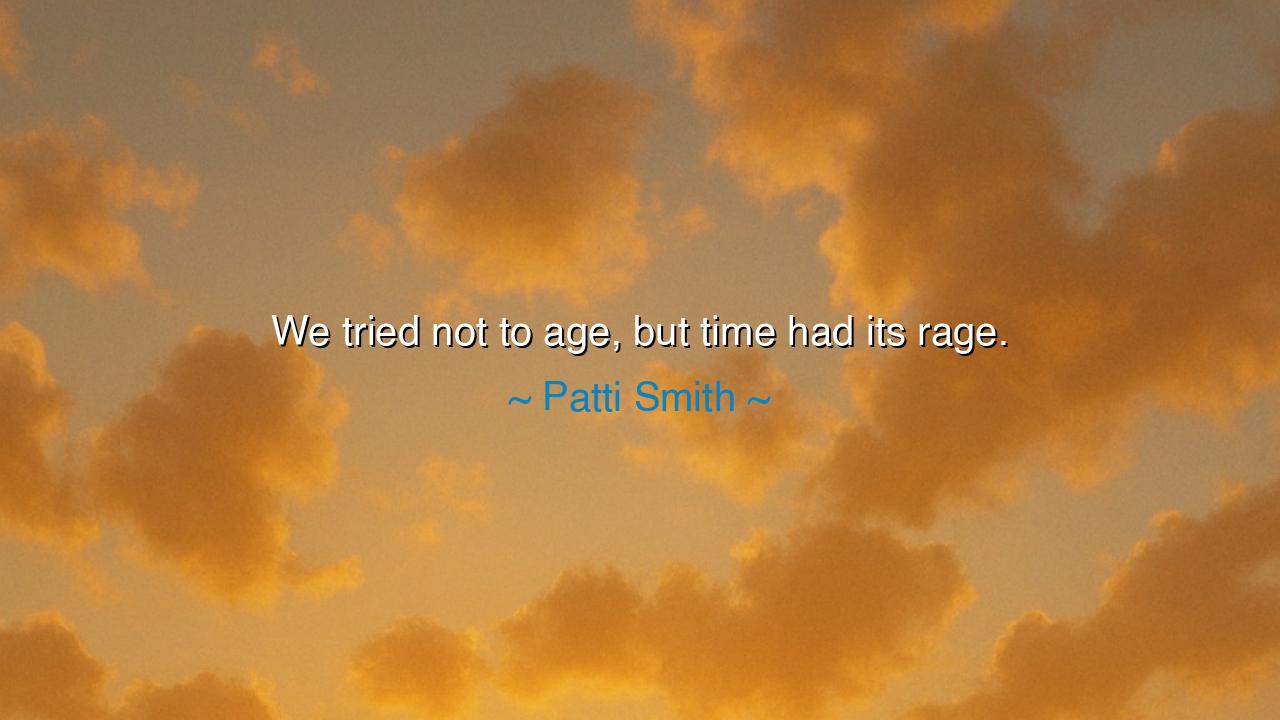
We tried not to age, but time had its rage.






"We tried not to age, but time had its rage." These words, spoken by the legendary Patti Smith, speak to a truth as ancient as humanity itself: the relentless, unstoppable passage of time. In her reflection, Smith captures the human struggle to resist the inevitable march of time, the force that spares no one and bends everything to its will. Aging is not a quiet, gradual process; it is a storm, a rage that comes not to destroy, but to transform. Despite our efforts, despite the vanity and the desire to preserve our youth, time always asserts itself, leaving its marks upon our bodies, our spirits, and our very existence.
The ancients understood this truth well. The Greek myths were filled with stories of gods and heroes who tried to escape the ravages of time. Take, for instance, the story of Tithonus, a mortal who was granted immortality by the gods, but at the cost of eternal aging. He could not escape time’s fury, and as he lived on, his body withered, a mere shadow of the person he once was. In his eternal life, Tithonus found that immortality without the vitality of youth was a cruel gift. Time, in its ceaseless rage, is not something we can outrun, and no matter how we try to defy it, we are always subject to its force.
This truth is echoed in the Roman philosophy of Stoicism, which taught that one must accept the passage of time as part of the natural order of life. The Stoics understood that aging was inevitable, but they also understood that how we face time’s fury is what truly matters. Seneca, in his writings, emphasized that one should live each day with purpose, for it is not the length of life that matters, but the quality of the life lived. To try to fight time’s rage is to waste the precious moments we are given. Instead, the wise embrace the fleeting nature of existence and seek to make their time meaningful, knowing that youth is a gift, but so too is the wisdom that comes with age.
Like Seneca, Smith speaks not just of the inevitability of aging, but of the fierce emotion and desperation with which we cling to youth. To "try not to age" is to deny the truth of our mortality, to push against the tide of life itself. Yet, Smith’s words acknowledge that despite our efforts, time is more powerful than any of us. The rage of time is not just a force of destruction but a reminder of our impermanence. Just as the ancients taught, our best response to the passage of time is not resistance, but acceptance and appreciation for the fleeting beauty of each moment.
Consider the life of Leonardo da Vinci, who, in his later years, faced the inevitability of aging. Yet, even as his body weakened, his mind remained sharp. Da Vinci's work, from his paintings to his inventions, reflected a man who, though acutely aware of time’s passage, did not surrender to it in despair. Instead, he embraced the time he had left, creating masterpieces that would outlast him. Da Vinci, like Smith, understood that time has its rage, but how we respond to it—through creativity, passion, and purpose—is what allows us to transcend its limits. In his aging body, Leonardo's work remained timeless, proof that while youth fades, the impact of a life well-lived endures.
The lesson of Patti Smith’s words is not one of hopelessness but of profound acceptance. The rage of time is a force that cannot be resisted forever, but we are not powerless in its wake. Time teaches us that life is fleeting, that youth is not an endless spring but a season that must eventually give way to winter. And yet, in this acceptance, there is freedom. For when we understand the transitory nature of all things, we are free to live fully, to create, to love, and to experience the world with depth and vigor, regardless of age. The secret to facing time’s rage is not to fight it, but to embrace it and to find meaning in each passing moment.
Thus, the lesson we must take from Smith's reflection is this: do not be consumed by the desire to defy time’s fury. Instead, live with intention, knowing that each moment is precious and fleeting. Let the passing of time be a reminder to act with purpose, to cherish the present, and to celebrate both youth and age for the gifts they bring. Aging is not a curse, but a reminder of the beauty and fragility of life. As time rages on, let us find strength not in resisting it, but in living fully within it, creating legacies that will outlast even the fiercest storms of time.






AAdministratorAdministrator
Welcome, honored guests. Please leave a comment, we will respond soon